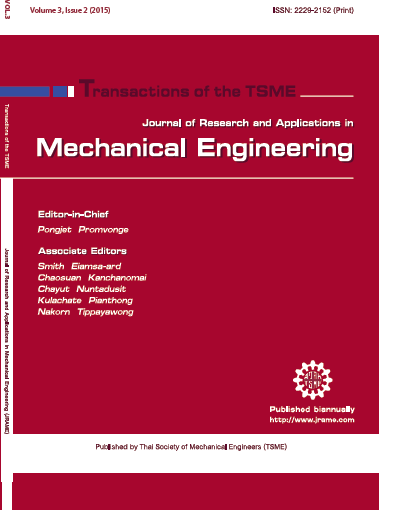Effects of torrefaction process on physical properties and operating cost of biomass powder
Main Article Content
Abstract
The cassava rhizome was used as raw material. The torrefaction process was experimented in 2 cases. In the first case, the cassava rhizome was chopped. The temperature and residence times of torrefaction process were determined at 250 ºC and 90 minutes, respectively. Then, torrefied cassava rhizome was minced. In the second case, the cassava rhizome was chopped and minced. Then, it was torrefied at the same temperature and residence times of the previous case. The lower heating value (LHV), moisture content, particle size and operating cost were studied in both cases. The results were found that the highest LHV of torrefied cassava rhizome ranged from 21.9±0.07 MJ/kg to 22.55±1.39 MJ/kg. The lowest moisture content of torrefied cassava rhizome ranged from 1.41±0.73% to 1.05±0.27%. In addition, the total production cost of case1 was the cheapest (3.57 baht/kg), its cost differed from that of case2 by 9.8% (3.92 Baht/kg). It was concluded that, torrefaction process should be started with chopping, torrefying and followed by mincing. The operating cost, particle size and cost per energy output were decreased by using torrefying process (case1).
Article Details
This work is licensed under a Creative Commons Attribution-NonCommercial-ShareAlike 4.0 International License.
References
[2] Medic, D., Darr, M., Shah, A., Potter, B. and Zimmerman, J. Effects of torrefaction process parameters on biomass feedstock upgrading, Fuel, Vol. 91, 2012, pp. 147-154.
[3] Shang, L., Ahrenfeldt, J., Holm, J.K., Barsberg, S., Zhang, R.Z., Luo, Y.H., Egsgaard, H. and Henriksen, U.B. Intrinsic kinetics and devolatilization of wheat straw during torrefaction, Journal of Analytical and Applied Pyrolysis, Vol. 100, 2013, pp. 145-152.
[4] Prins, M.J., Ptasinski, K.J. and Janssen, F.J.J.G. Torrefaction of wood: Part 1. Weight loss kinetics, Journal of Analytical and Applied Pyrolysis, Vol. 77, 2006, pp. 28-34.
[5] Prins, M.J., Ptasinski, K.J. and Janssen, F.J.J.G. Torrefaction of wood: Part 2. Analysis of products, Journal of Analytical and Applied Pyrolysis, Vol. 77, 2006, pp. 35-40.
[6] Chew, J.J. and Doshi, V. Recent advances in biomass pretreatment-Torrefaction fundamentals and technology, Renewable and Sustainable Energy Reviews, Vol. 15, 2011, pp. 4212-4222.
[7] Chen, W.H., Hsu, H.C., Lu, K.M., Lee, W.J. Lin, T.C. Thermal pretreatment of wood (Lauan) block by torrefaction and its influence on the properties of the biomass, Energy, Vol. 36, 2011, pp. 3012-3021
[8] Bergman, P.C.A., Boersma, A.R., Zwart, R.W.R. and Kiel, J.H.A. Torrefaction for biomass co-firing in existing coal-fired power stations, Energy research Centre of the Netherlands (ECN), 2005.
[9] Bridgeman, T.G., Jones, J.M., Williams, A. and Waldron, D.J. An investigation of the grindability of two torrefied energy crops, Fuel, Vol. 89, 2010, pp. 3911-3918.
[10] Phanphanich, M. and Mani, S. Impact of torrefaction on the grindability and fuel characteristics of forest biomass, Bioresource Technology, Vol. 102, 2011, pp. 1246-1253.
[11] Junsatien, W., Soponpongpipat, N. and Phetsong, S. Torrefaction Reactors, Journal of Science and Technology Mahasarakham University, Vol. 32, 2013, pp. 84-91.
[12] ASTM E871-82, Standard Test Method for Moisture Analysis of Particulate Wood Fuels.
[13] ASTM E711-87, Standard Test Method for Gross Calorific Value of Refuse-Derived Fuel by the Bomb Calorimeter.
[14] ASTM D422, Standard Test Method for Particle-Size Analysis of Soils.



